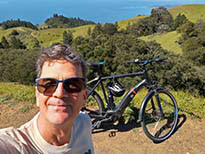The verdict is in, and it looks like the ocean goddess is going to show her cooler side this year. Strong equatorial winds are pushing sun-kissed surface waters west, bringing cold water up from the deeps and sending it farther north than usual. One result of the colder ocean waters will be less rain for California.
Friday, September 11, 2020
Beach Weather
Thursday, September 10, 2020
Complementary Color
We lucked out today, as an area of low pressure moved in (windy.com). All that NorCal and Oregonian smoke that was streaming down the coast yesterday is now going the other way, and out to sea.
Wednesday, September 9, 2020
Amber Alert
My wife was trying to use her phone camera to capture the eerie amber light around sunrise this morning, but it wouldn't work. The software refused to believe it really looked that strange.
I woke up from a poor night's sleep, having spent too much time at around 1 a.m. thinking about how climate scientists have been sounding the alarm for decades while we twiddle our collective thumbs. The group called 350.org was named for the CO2 target of 350 ppm, a greenhouse gas concentration that we passed in 1990. We surpassed 400 ppm in 2016 and are at 412 ppm now. We are simultaneously making history and ending it.
Multi-cam View
Last year marked the first time in several million years that atmospheric concentrations of CO2 passed 400 parts per million. By looking at what Earth’s climate was like in previous eras of high CO2 levels, scientists are getting a sobering picture of where we are headed.
[UPDATE: Earth Day, 4/22/2024, atmospheric CO2 at 426ppm.]
* * *
Tuesday, September 8, 2020
Beach Birds
These Drake's Beach scenes are from September 2014, right in the middle of the 2011-2017 drought that killed millions of trees which became tinder for forest fires, and which caused billions of dollars in agricultural losses.
Monday, September 7, 2020
Photo Shop 1984
This was my photo shop long before it became Photoshop. I found this picture yesterday while I was looking for something else and thought I would post it. And then I changed my mind. But then I read a good interview with Craig Newmark this morning and decided to post the picture and this really good bit from Craig, discussing his philanthropy in the realm of journalism:
In 2016, you started Craig Newmark Philanthropies. And under that you fund many, many initiatives. In particular, you’ve given millions of dollars away to support journalism and protect press freedom. Why is this such an important issue to you and what do you hope to achieve? The principles are from high school history and civics taught by Mr. Schulzki in 1970. He said, “A trustworthy press is the immune system of democracy.” And yet in 2016, we were attacked by a hostile foreign power using information warfare techniques to place an asset in high office. It’s incumbent upon patriotic Americans to fight back, to work together, and to take the battle to the enemy.
I’m working with people in journalism, cybersecurity, studying disinformation and voter suppression. I’m working to try to protect the country because we are at war. My dad had World War II where he fought in the Pacific; I figure I have what Marshall McLuhan called “World War III,” a guerrilla information war fought without distinction between civilian and military participants. That’s the only thing he said that I ever understood.
https://nobhillgazette.com/the-interview-craig-beyond-the-list/
* * *
Warm Cockles
Sunday, September 6, 2020
Habitats for Humanity
Saturday, September 5, 2020
Spiders of September
As I was sitting out back just now I noticed this orb-weaver spider in her web spanning part of the width of a basement door that rarely gets opened. I went upstairs to get my camera and brought along a water mister to spray on her web, but the mist didn't really stick. Maybe the strands of the web are just too thin to hold decent sized droplets.
I also remembered to look up the reason why it seems like I see more spider webs in the garden in the late summer and early fall, and the answer was that the females that hatched in spring have finally gotten big enough to notice. The smaller males are roaming the earth in search of females, who will lay their eggs before winter sets in.
And since I already had my camera out, I decided to clean the sensor since I've been putting it off for some time. I put it off because no one has invented a tiny vacuum cleaner or some other easy and effective method of doing the job. It always takes several iterations of snapping a picture of the sky with my 50mm lens stopped down to f/16, then importing the image into Lightroom so I can see where the spots are. Sometimes I'll do the cleaning, only to check the sensor and find it even more spotty than before I cleaned it, which never makes me happy. What does make me happy is when I somehow finally get the thing in good shape.
* * *
Friday, September 4, 2020
The Nature of Nature
Thursday, September 3, 2020
Cypress & Fog
* * *



































